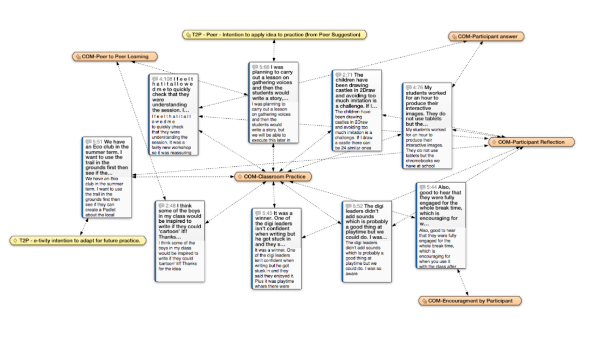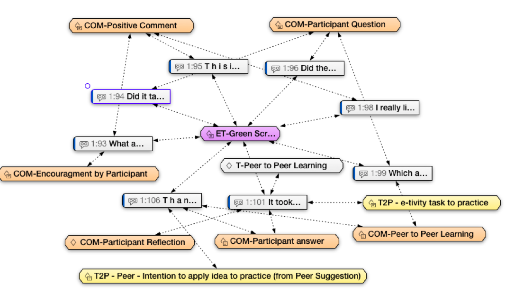Visualisations supporting analysis of interactions
Analysis of interactions across a range of media using Atlas.ti.
Inductive examination of qualitative data to identify key themes.
Use of codes to explore relationships.
Analysis of online interactions - across G+ Community and Twitter.
Participants posted evidence of e-tivities to G+, under a different category for each week. Samples of these posts were taken for analysis - every third post made by participants was taken from all categories and analysed using coding in Atlas.ti. The storify of each Twitter Chat for each week and other data from video and multi-modal reflections on Thinglink were also analysed. Codes were developed relating to the research questions. These were predominantly examples of transfer to practice and identifying ways in which this was happening.
Through looking at the number of each examples of each code, themes started to emerge. Atlas.ti allows us to examine this qualitative data further. By taking one code, we can collate and display examples of where it has been used across the range of media. We can then examine what other codes are associated with these examples and identify links. This allows us to display all related evidence and start theorising with all relevant examples across all media in front of us, as is shown in the Green screening example.
Here are some linked codes: many of these comments are linked to reflection. We can see that many of the comments on classroom practice are linked to reflection and peer to peer learning. We can therefore see that participants are learning from each other.
Questioning and reflection, both by participants and moderators often led to statements of intent to transfer to practice or evidence of actual transfer to practice.
Where there were clear roles at the beginning (participants and moderators) these appeared to blur as the course continued. Moderators learned from participants and vice versa. Participants took on the role as the expert, sharing and answering questions of other participants.
The journey into practice was not always as straightforward as we expected. Participants did not just take the suggested sample activities presented in the eTivities and other MOOC material and directly transfer it. Instead, they seemed to reflect on the provided material and discuss it in the various communities, where they engaged in peer to peer learning about the uses and possible impact of the new practices. Often, when participants did successfully transfer content from the MOOC to their practice, they did so after this interaction and a subsequent period of self-reflection. Only then did they apply the new practice to their context, following it up with a reflective post on the activity in the MOOC community.
In the MOOC creating the artefacts was a catalyst for individual understanding and reflection, and then the sharing of the artefacts appeared to be a springboard for more learning. Analysis of the interactions in the MOOC suggests that something aligned with rhizomatic learning (Cormier 2011) is taking place. This ties in with Smith et al.’s suggestion that online learning is a process of participation and reification (2017).
References:
Cormier, D., 2011. Rhizomatic learning-why we teach.
Smith, S.U., Hayes, S. and Shea, P., 2017. A critical review of the use of Wenger's Community of Practice (CoP) theoretical framework in online and blended learning research, 2000-2014. Online Learning, 21(1).




